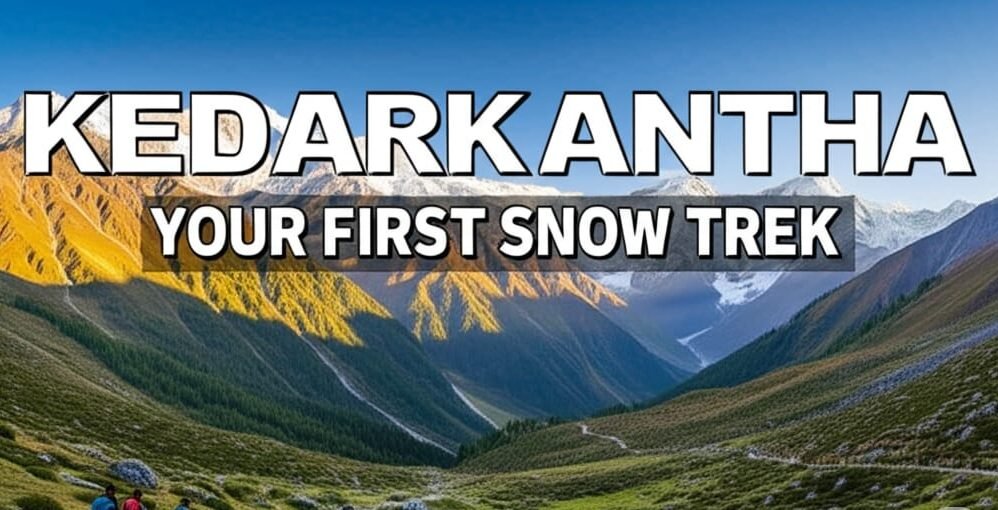It started, as most questionable adventures do, with a simple text in our four-person friend group: “Kedarkantha trek this weekend?” We were in Delhi, enjoying a pleasant 16°C winter. We had zero trekking gear, zero high-altitude experience, and a level of fitness that was, let’s say, more suited to navigating metro crowds than mountains.
We said yes.
This is the real story of what happens when four city-dwellers impulsively decide to take on one of India’s most famous winter treks. It’s a story of freezing nights, breathtaking sunrises, unexpected friendships, and the honest, unfiltered truth about what it takes to reach 12,500 feet.
For anyone thinking of doing this, here’s the overview. The trek starts from Sankri village in Uttarakhand, a long drive from Dehradun. It’s a 4-day trek, generally considered beginner-friendly, but don’t let that fool you. “Beginner-friendly” in the Himalayas is a different league of difficulty.
Day 1: From Delhi’s Comfort to Sankri’s Chaos
The journey began with an overnight bus to Dehradun, followed by a long, winding ride in a shared traveller to Sankri. The real adventure started in Sankri’s gear rental shop. We were clueless. We looked at the rows of jackets, poles, and strange-looking shoe covers (gaiters, we learned) with wide eyes. We rented everything: sub-zero jackets that made us look like marshmallows, gaiters to keep snow out of our shoes, and the most crucial item of all—spikes for our boots. Honest Tip: If it’s your first time, rent. Don’t invest until you know you love the pain.
Day 2: Juda Ka Talab and a Surprise Garba Party
The first day’s trek is to Juda Ka Talab. The moment our shoes hit the first patch of snow, we were like excited kids. The initial climb was beautiful, surrounded by snow-laden pines. We thought, “This isn’t so bad!” We were wrong. We thought we were fit, but the altitude and the incline quickly humbled us.
That evening, something magical happened. Another group, a wonderful family from Gujarat, started playing music. Before we knew it, we were all linked in a circle, learning Garba steps in the middle of a snowy Himalayan campsite. It was surreal, joyous, and a perfect distraction from the dropping temperature.
The real test came at night. Inside the tent, the temperature plummeted. No amount of YouTube videos can prepare you for the feeling of -10°C when all you have is a sleeping bag between you and the frozen ground. Sleep was a distant dream.
Day 3: The Stunning Views from Base Camp
Waking up to a world of white, we finally understood the importance of our rented gear. The spikes gave us confidence on icy patches, and the gaiters were a blessing. The trek to the Kedarkantha Base Camp was tougher but offered staggering views of the surrounding peaks. We engaged in the mandatory snowball fight, took a hundred pictures, and felt a growing sense of awe and anxiety. The summit was now visible, a distant, intimidating peak.
Day 4: The Summit Push (-12°C and a Million Stars)
Our day started at 2 AM. It was pitch black and freezing cold. The only light came from our headlamps, creating small pools of visibility in an ocean of darkness. This is where the trek becomes a mental game. You can’t see the summit, you can only see the boots of the person in front of you. You just have to keep walking.
The wind was brutal, and my hands, even with gloves, felt like blocks of ice. At one point, completely exhausted, I asked our guide how much was left. He smiled and said, “Bas 10 percent.” It was the most demotivating and motivating thing I’d ever heard.
But then, the magic began. The sky started to turn from inky black to a deep indigo, then to orange. The first rays of sunlight hit the distant snow-capped peaks, setting them on fire. At -12°C, all you want is sunlight and a cup of chai, and seeing that sunrise felt like a divine blessing.
Reaching the summit at 12,500 ft is a feeling I can’t describe. We were breathless, exhausted, and overwhelmed with emotion. We had done it. We stood in silence, looking at a 360-degree panorama of the mighty Himalayas.
Another Honest Tip: The descent is scarier than the climb. Your legs are tired, and the steep, snowy slopes are treacherous. Go slow.
A First-Timer’s Guide to Surviving Kedarkantha
- Acclimatize, Acclimatize, Acclimatize: Don’t rush. Let your body get used to the altitude in Sankri.
- Hydration is Key: Drink water constantly, even when you don’t feel thirsty. It’s the best way to combat altitude sickness.
- No Network, No Electricity: After Sankri, your phone is just a camera. Carry a power bank. Inform your family you’ll be offline.
- Trust Your Guide: These mountains are their home. Listen to them.
- It’s Not a Race: Go at your own pace. The mountain will still be there.
A Final Reflection
Videos make snow treks look easy and glamorous. Real life hits harder. It’s about the struggle, the cold that seeps into your bones, and the moments you doubt you can take another step. But it’s also about the incredible bond you form with your friends, the shared laughter over a bowl of Maggi, the kindness of strangers teaching you Garba, and the profound, life-altering moment you stand on a Himalayan summit and watch the world wake up below you.
We came back with no network, no heat for four days, but absolutely no regrets. Kedarkantha didn’t just give us a summit photo; it gave us a story and changed us from within.

Leave a Reply